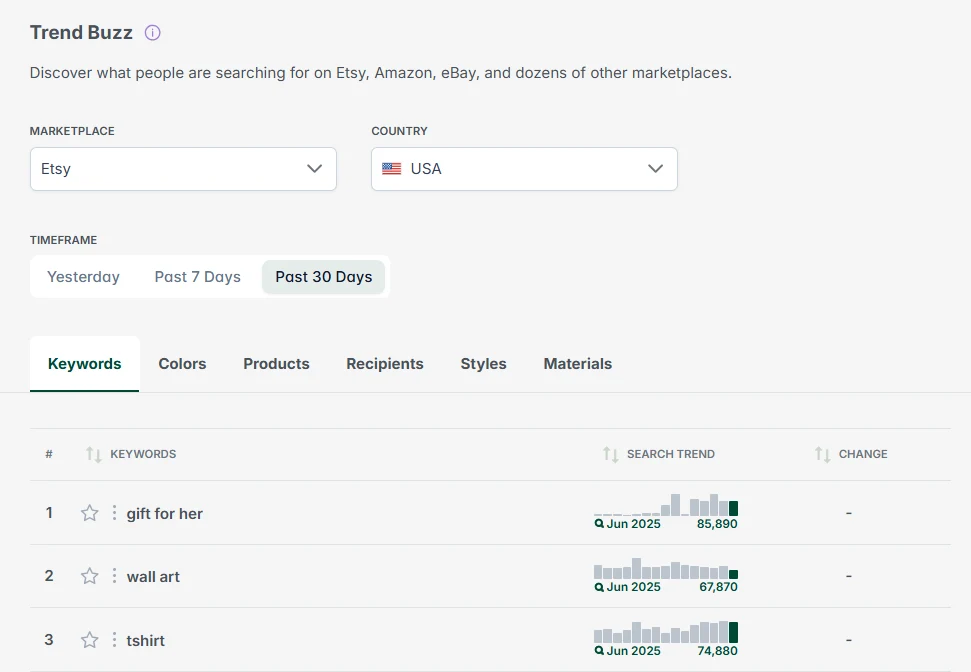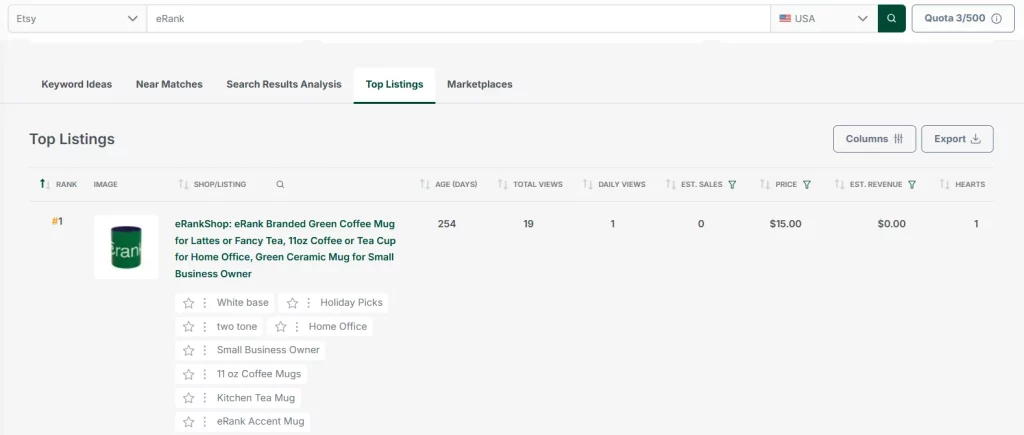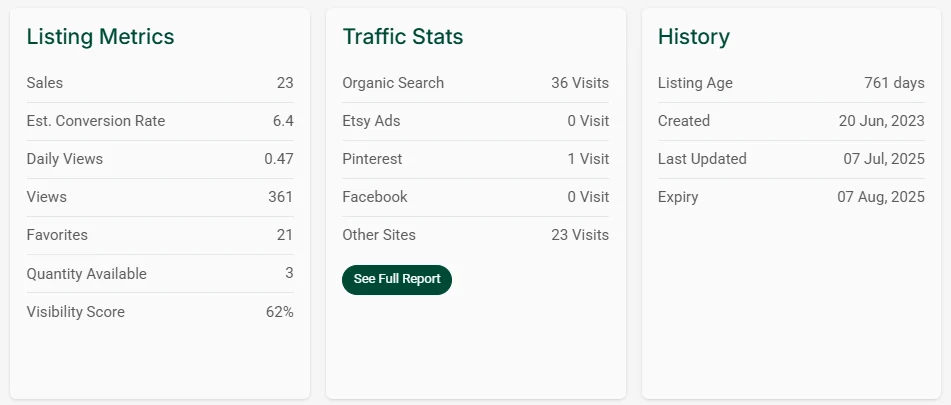Wondering how to grow your Etsy shop? Want to dive into keyword data, track competitors, and improve your listings? eRank’s SEO tools can help you get more sales on Etsy.
From finding trending keywords to performing listing audits, eRank’s suite of powerful tools is here to help you succeed. Whether you’re just starting on Etsy or a seasoned seller looking to expand, there are tools and plans just for you!
Let’s discuss how you can start using eRank to work towards increasing your sales on Etsy.
Why Should You Want to Get More Sales on Etsy?
Aside from the obvious reasons, like making more money, why is it so important to increase your sales on Etsy? At the end of the day, the answer is simple: more sales help boost your authority. As your orders increase, Etsy’s algorithm learns that you’re a reliable shop for specific keywords.
With over 100 million products on Etsy, having authority can mean the difference between being found by a shopper or getting lost in a sea of more than eight million Etsy shops.
In addition, the more sales you make and the more positive reviews you receive, the higher your shop’s quality score will be. This is another factor in Etsy’s algorithm that determines your search placement (or “rank”). What you do to build customer trust, inspire their loyalty, and create buzz around your brand all play a role in growing your Etsy shop.
To learn more about the factors that go into Etsy’s ranking system, read this article from the platform’s Seller Handbook.
Tools to Help with Keyword Research and Trend Data
On Etsy, nearly 95 million shoppers are searching for all kinds of different keywords. You want to attract the ones looking for exactly what you sell. The best way to do that is by using the exact same keywords they’re using. Taking the time to find and use these keywords is one aspect of search engine optimization, more commonly referred to as “SEO.”
So, how do you find these relevant keywords? Use eRank’s Keyword Tool, one of the most powerful Etsy SEO tools available. Just type in any keyword and this powerful tool shows you metrics such as average searches per month and competition rates on Etsy and across dozens of other platforms.
In addition, this tool performs a detailed analysis of the top 100 listings found in Etsy’s search results for that keyword.
The Keyword Tool also shows:
- The most popular tags used by Etsy sellers
- How often the keywords in those tags are searched on Etsy
- Common price points for products that share those tags
- And much, much more!
Another way to attract potential buyers is to be one of the first shops to jump on new trends. With eRank’s Trend Buzz tool, you can explore the hottest Etsy trends and popular Etsy keywords. This tool shows the top 100 keywords shoppers used yesterday, over the past week, and over the past 30 days. You can see keywords from seven different countries and multiple marketplaces.

With the Monthly Trends tool, you can browse any Etsy category to see stats on its top 100 keywords. Use the date drop-down menu to view data from any of the past 15 months. Use the filter field if you want to search for a particular keyword.
This tool provides an interactive, 15-month trend graph of historical data for each term. These graphs help you spot whether that term is rising or falling in popularity. Just hover your cursor over any bar in a trend graph to view a pop-up showing the month and its data.
Use these insights to guide your Etsy keyword research and plan listings around rising search terms. All while, of course, making sure that the terms you choose to utilize still align with your products and audience.
Use eRank to Track and Learn from Your Competitors
To get ahead on Etsy, it’s essential to conduct a thorough analysis of your top competitors. But how do you find them? One way is by using eRank’s Keyword Tool. After searching your superstar keyword, scroll down and select the “Top Listings” tab. There, you’ll see the Top 100 listings that rank on Etsy for that keyword, excluding Etsy ads and personalization.

Take a look at the top listings and check which tags your competitors are using. To save any of their tags to one of your own Keyword Lists, click the star icon next to that keyword. This approach helps you track Etsy competitors more effectively and refine your own Etsy shop optimization strategy.
To take a deep dive into a specific shop’s listings, tags, and estimated sales metrics, use eRank’s Shop Info tool. Just type any Etsy shop’s name into the search bar and click the green “Find” button next to it. This tool is a “one-stop shop” for learning about that shop. Click the star next to the shop’s name to save it to your Competitor Sales list.

When viewing their top listings and tags, save any that could be effective for your own listings using the star, just like in the Keyword Tool.
It’s important to remember that your top competitors may not always have the most optimized tag strategy. However, analyzing their tags can still give you valuable insights to test and refine your own strategy for better results.
Learn How to Improve and Optimize Your Product Listings
Another way to potentially increase your Etsy sales is by reviewing your listings and spotting opportunities to improve them. eRank’s Listings tool helps you improve Etsy listings with data-backed recommendations. It shows metrics for your most recently updated listings and highlights those that may need attention. You’ll see which listings are missing photos or tags, have low visibility scores, or have other issues that could be solved with an SEO update.
Click the “Listing Audit” button under any title to view a multitude of valuable statistics about that listing. These comprehensive audits measure how well your listing aligns with Etsy’s The Ultimate Guide to Etsy Search and Google Search Essentials. You’ll see data on sales, visibility scores, traffic stats, and more.

Scroll down to the “SEO Tips” section to view eRank’s tips on how to improve your listing. These tips can help you better optimize for Etsy search, potentially increasing your chances of ranking. It’s important to make time to complete your Etsy shop optimization process for both the algorithm and for shoppers.
💡 Remember eRank’s Golden Rule: never touch the SEO of a listing that is performing well! You may accidentally remove high-performing keywords that are bringing traffic to your shop.
eRank’s Tools Can Help You Improve Your Etsy Shop
With eRank by your side, you don’t have to figure it all out on your own. From Etsy keyword research and trend tracking to Etsy shop optimization and competitor tools, we’re here to help you attract the right traffic and turn it into sales.
Explore our Tools, dive into our blog, and subscribe to our YouTube channel for ongoing tips, walkthroughs, and expert advice. The more you learn, the better you can position your Etsy store for long-term success. 🌱









